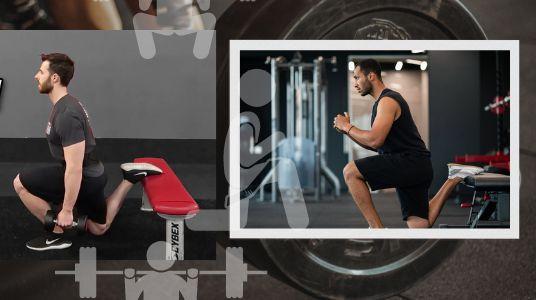Introduction to the Bulgarian Split Squat
The Bulgarian Split Squat, often just called the Split Squat, is a powerful unilateral exercise that brings to the table a range of benefits, especially for those aiming to enhance their lower body strength, stability, and flexibility.
Benefits of Bulgarian Squat:
Muscle Activation: This movement targets the quadriceps, hamstrings, glutes, and calves. Due to its unilateral nature, each leg works independently, ensuring balanced strength and development on both sides.
Improved Balance: Performing the exercise correctly requires significant stabilization, helping in improving overall balance and proprioception.
Flexibility and Mobility: Regular practice can lead to improved hip flexor flexibility, which is essential for overall leg mobility and injury prevention.
Stiff Leg Deadlift: A Game-Changer for Hamstring Development
Introduction and Benefits of the Stiff Leg Deadlift
The Stiff Leg Deadlift, distinct from its close relative, the traditional deadlift, is a paramount exercise focusing primarily on the hamstrings and lower back. Its emphasis on the posterior chain makes it a must-add to any serious workout regimen.
Benefits:
Targeted Hamstring Development: Unlike many leg exercises that target the quadriceps, the stiff leg deadlift zones in on the hamstrings, ensuring robust development.
Enhanced Posterior Chain Strength: This exercise also activates the glutes and lower back, leading to a stronger and well-balanced posterior chain.
Improved Core Stability: Engaging the core to maintain a straight back during the movement increases core strength and stability.
Stiff Leg Deadlift Form:
Keys to Mastery To reap the full benefits and to avoid potential injury, mastering the form is crucial. Here’s a step-by-step guide:
Starting Position: Begin with feet hip-width apart, holding a barbell in front of you with an overhand grip.
Movement Initiation: With a slight bend in the knees, push your hips back as you lower the barbell, keeping it close to your legs.
Maintain a Neutral Spine: Ensure your back remains straight, and avoid rounding the shoulders. Engage the core throughout.
Lifting: Use your hamstrings and glutes to pull the weight up, returning to the starting position.
Common Mistakes:
Rounding the Back: This puts undue stress on the spine and can lead to injuries.
Bending the Knees Too Much: Remember, it’s not a traditional deadlift. Pay Attention to Your Hamstrings for Better Focus.
Dumbbell Stiff Leg Deadlift:

Enhanced Stabilization: Using dumbbells can challenge stability even further, engaging smaller stabilizing muscles.
Flexibility in Movement: Dumbbells allow for a more natural range of motion, which can be more comfortable for those with certain mobility issues.
Comparison with the Standard Stiff Leg Deadlift:
While the primary muscles targeted remain the same, the dumbbell variation might feel more approachable for beginners or those without access to a barbell.Unlocking the Power of the Leg Press for Glutes
Harnessing the Leg Press for Glute Activation
Often overshadowed by squats and deadlifts in the realm of leg exercises, the leg press is a formidable movement that offers a plethora of benefits, especially when aiming to sculpt those glutes.
The leg press machine is typically found in most gyms and comes in a variety of designs. While primarily known for targeting the quadriceps, with slight modifications to form and foot placement, it can be a glute-building powerhouse.
Benefits:
- Safety: The machine provides support, reducing the risk of injury, especially for those new to weightlifting or those lifting heavy weights.
- Targeted Muscle Activation: Adjusting foot placement can shift focus between the quadriceps, hamstrings, and glutes.
- Adaptability: Suitable for all fitness levels, from beginners to seasoned athletes.
Seated Leg Press for Glutes: A Deep Dive
The seated leg press, one of the common variations of the leg press machine, is an exercise worth integrating into your leg day routine, particularly if glute activation is your goal.
Distinguishing the Seated Leg Press from Other Variations
- Positioning: As the name suggests, the seated leg press involves a seated, often slightly reclined, position, as opposed to the 45-degree leg press where users lie at an angle.
- Foot Placement: To emphasize the glutes, place your feet higher on the footplate. This position lengthens the range of motion of the hip joint, requiring the glutes to work harder.
- Controlled Movement: Slow, controlled presses, especially during the eccentric (or lowering) phase, further engage the gluteal muscles.
Tips for Enhanced Glute Activation on the Seated Leg Press:
- Wide Stance: A wider foot stance can engage the gluteus medius and minimus more effectively.
- Deep Presses: Aim for a deeper press to get a fuller range of motion, activating the glutes to their maximum potential.
Elevate Your Glute Game with the Barbell Hip Thrust
Introduction to the Barbell Hip Thrust
Diving further into glute-specific exercises, we come across the ever-effective Barbell Hip Thrust. Arguably one of the most potent movements to activate the glutes, this exercise has gained considerable traction in both athlete and casual fitness circles.
Unique Benefits of the Barbell Hip Thrust:
- Peak Glute Activation: Studies have shown that hip thrusts activate the glutes more than most other exercises.
- Spinal Safety: As the movement puts minimal stress on the lumbar spine, it’s a safer alternative to some traditional lifts.
- Functional Strength: Improving hip extension strength can benefit daily activities and athletic performance.
Muscles Engaged During the Hip Thrust
While the primary focus is the glutes, hip thrusts are a compound movement, meaning they target multiple muscles:
- Gluteus Maximus: The primary mover, responsible for the upward thrusting motion.
- Hamstrings: These play a supportive role, especially as you reach full hip extension.
- Core Muscles: Engaged throughout the movement for stability and protection.
Engaging these muscles not only shapes and tones the lower body but also promotes overall functional fitness, improving movement efficiency in various sports and daily activities.
Exploring Hip Thrust Variations
While the barbell version is popular, there are multiple ways to perform a hip thrust:
- Single-leg Hip Thrust: Performed without weights, this version targets one side at a time, improving muscular imbalances.
- Banded Hip Thrust: Incorporating resistance bands either in conjunction or as a replacement to weights, adding a different resistance curve to the movement.
- Smith Machine Hip Thrust: Utilizing the Smith machine for guided and stable movement, especially beneficial for those new to the exercise.
Alternatives to the Barbell Hip Thrust
There are numerous reasons someone might seek an alternative:
- Equipment Limitations: Not all gym-goers have access to a suitable barbell or bench setup.
- Comfort: Some might find the barbell uncomfortable on their hips or challenging to position.
Progression & Regression: Beginners might seek simpler versions, while advanced lifters might want an added challenge.
Non-Barbell Hip Thrust Variations Worth Exploring:
- Weight Plate Hip Thrust: Using a weight plate can be more comfortable for those finding barbells daunting or uncomfortable.
- Machine Hip Thrust: Some gyms have machines specifically designed for this movement, providing a controlled environment to perform the exercise.
Conclusion: The Power of the Hip Thrust in Holistic Fitness
As we wrap up this exploration of glute-focused exercises, the hip thrust stands out as a must-try. Whether you’re wielding a barbell, resistance band, or just your body weight, this movement promises peak glute engagement. Coupled with its safety profile and versatility, it’s no wonder the hip thrust has become a staple in many fitness routines. Remember, the journey to fitness isn’t about following trends but understanding and applying exercises that align with your goals. With the right technique and dedication, the hip thrust can be a transformative addition to your regim
FAQ’S
- What is a Bulgarian Split Squat?
The Bulgarian Split Squat is a lower-body exercise where one foot is elevated behind the exerciser, targeting the glutes, hamstrings, and quads. - How does the Stiff Leg Deadlift differ from the regular Deadlift?
While both exercises target the posterior chain, the Stiff Leg Deadlift places more emphasis on the hamstrings due to the legs being kept straighter. - Is the Leg Press effective for glute activation?
Yes, especially when using specific variations like the Seated Leg Press, which can emphasize glute activation when performed correctly. - Why opt for a Barbell Hip Thrust?
The Barbell Hip Thrust specifically targets the glutes, offering better resistance and muscle activation compared to many other exercises. - What are some alternatives to the Barbell Hip Thrust?
There are various alternatives like resistance band hip thrusts, single-leg hip thrusts, and glute bridges, which can also effectively target the glutes. - How often should these exercises be incorporated into a workout routine?
It’s typically recommended to train major muscle groups, like the glutes, 2-3 times a week. However, individual goals and fitness levels can affect this frequency.


